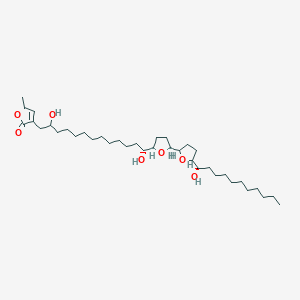| MeSH term | MeSH ID | Detail |
|---|---|---|
| Adenocarcinoma | D000230 | 166 associated lipids |
| Carcinoma, Hepatocellular | D006528 | 140 associated lipids |
| Neoplasms, Glandular and Epithelial | D009375 | 12 associated lipids |
| Optic Atrophies, Hereditary | D015418 | 2 associated lipids |
Bullatacin
Bullatacin is a lipid of Polyketides (PK) class. The involved functions are known as inhibitors, Electron Transport, NADH-ubiquinone oxidoreductase activity, NADH oxidation and Point Mutation. Bullatacin often locates in NADH dehydrogenase complex and Submitochondrial Particles. The associated genes with Bullatacin are NDUFS7 gene, CCL14 wt Allele and TERT gene. The related lipids are Annonaceous Acetogenins.
Cross Reference
Introduction
To understand associated biological information of Bullatacin, we collected biological information of abnormalities, associated pathways, cellular/molecular locations, biological functions, related genes/proteins, lipids and common seen animal/experimental models with organized paragraphs from literatures.
What diseases are associated with Bullatacin?
There are no associated biomedical information in the current reference collection.
Possible diseases from mapped MeSH terms on references
We collected disease MeSH terms mapped to the references associated with Bullatacin
PubChem Associated disorders and diseases
What pathways are associated with Bullatacin
There are no associated biomedical information in the current reference collection.
PubChem Biomolecular Interactions and Pathways
Link to PubChem Biomolecular Interactions and PathwaysWhat cellular locations are associated with Bullatacin?
Visualization in cellular structure
Associated locations are in red color. Not associated locations are in black.
Related references are published most in these journals:
| Location | Cross reference | Weighted score | Related literatures |
|---|
What functions are associated with Bullatacin?
Related references are published most in these journals:
| Function | Cross reference | Weighted score | Related literatures |
|---|
What lipids are associated with Bullatacin?
Related references are published most in these journals:
| Lipid concept | Cross reference | Weighted score | Related literatures |
|---|
What genes are associated with Bullatacin?
Related references are published most in these journals:
| Gene | Cross reference | Weighted score | Related literatures |
|---|
What common seen animal models are associated with Bullatacin?
There are no associated biomedical information in the current reference collection.
NCBI Entrez Crosslinks
All references with Bullatacin
Download all related citations| Authors | Title | Published | Journal | PubMed Link |
|---|---|---|---|---|
| pmid: | ||||
| Xie BF et al. | [Antitumor effect of anuoning]. | 2002 | Ai Zheng | pmid:12452015 |
| Carelli V et al. | Biochemical features of mtDNA 14484 (ND6/M64V) point mutation associated with Leber's hereditary optic neuropathy. | 1999 | Ann. Neurol. | pmid:10072046 |
| Tormo JR et al. | Kinetic characterization of mitochondrial complex I inhibitors using annonaceous acetogenins. | 1999 | Arch. Biochem. Biophys. | pmid:10462447 |
| Myers MA et al. | Inhibition of mitochondrial oxidative phosphorylation induces hyper-expression of glutamic acid decarboxylase in pancreatic islet cells. | 1999 | Autoimmunity | pmid:10433094 |
| Estornell E et al. | Cherimolin-1, new selective inhibitor of the first energy-coupling site of the NADH: ubiquinone oxidoreductase (complex I). | 1997 | Biochem. Biophys. Res. Commun. | pmid:9367916 |
| Degli Esposti M et al. | Natural substances (acetogenins) from the family Annonaceae are powerful inhibitors of mitochondrial NADH dehydrogenase (Complex I). | 1994 | Biochem. J. | pmid:8037664 |
| Chiu HF et al. | Bullatacin, a potent antitumor Annonaceous acetogenin, induces apoptosis through a reduction of intracellular cAMP and cGMP levels in human hepatoma 2.2.15 cells. | 2003 | Biochem. Pharmacol. | pmid:12527325 |
| Shimada H et al. | Membrane conformations and their relation to cytotoxicity of asimicin and its analogues. | 1998 | Biochemistry | pmid:9454575 |
| Masuya T et al. | Pinpoint chemical modification of Asp160 in the 49 kDa subunit of bovine mitochondrial complex I via a combination of ligand-directed tosyl chemistry and click chemistry. | 2014 | Biochemistry | pmid:25419630 |
